Abstract
To explore the relation between androgens and prostatic hypertrophy in man, the concentrations of testosterone, dihydrotestosterone, and androstenedione and the rate of conversion of testosterone to dihydrotestosterone have been measured in normal and hypertrophic prostate tissue. First, a double isotope derivative technique was adapted for the measurement of tissue androgen content in 15 normal and 10 hypertrophic prostates. Although there was no significant difference in the content of androstenedione and testosterone between the two types of tissue, the content of dihydrotestosterone was significantly greater in the hypertrophic tissue (0.60 ±0.10 μg/100 g) than in the normal glands (0.13 ±0.05 μg/100 g). Second, a regional study was performed in three normal prostates and four glands with early hypertrophy, and it was demonstrated that the dihydrotestosterone content was two and three fold greater in the periurethral area where prostatic hypertrophy usually commences than in the outer regions of the gland. Finally, the rate of conversion of testosterone to dihydrotestosterone has been measured under standardized conditions in tissue slices from 4 normal and 20 hypertrophic prostates. There was no significant difference in the rate of dihydrotestosterone formation between the two types of gland (6.0 ±0.8 and 7.8 ±0.5 μμmoles/15 mg of tissue per hr). While the mechanism by which dihydrotestosterone accumulation occurs remains unexplained, it is possible that the local accumulation of dihydrotestosterone may be involved in the pathogenesis of prostatic hypertrophy in man.
Full text
PDF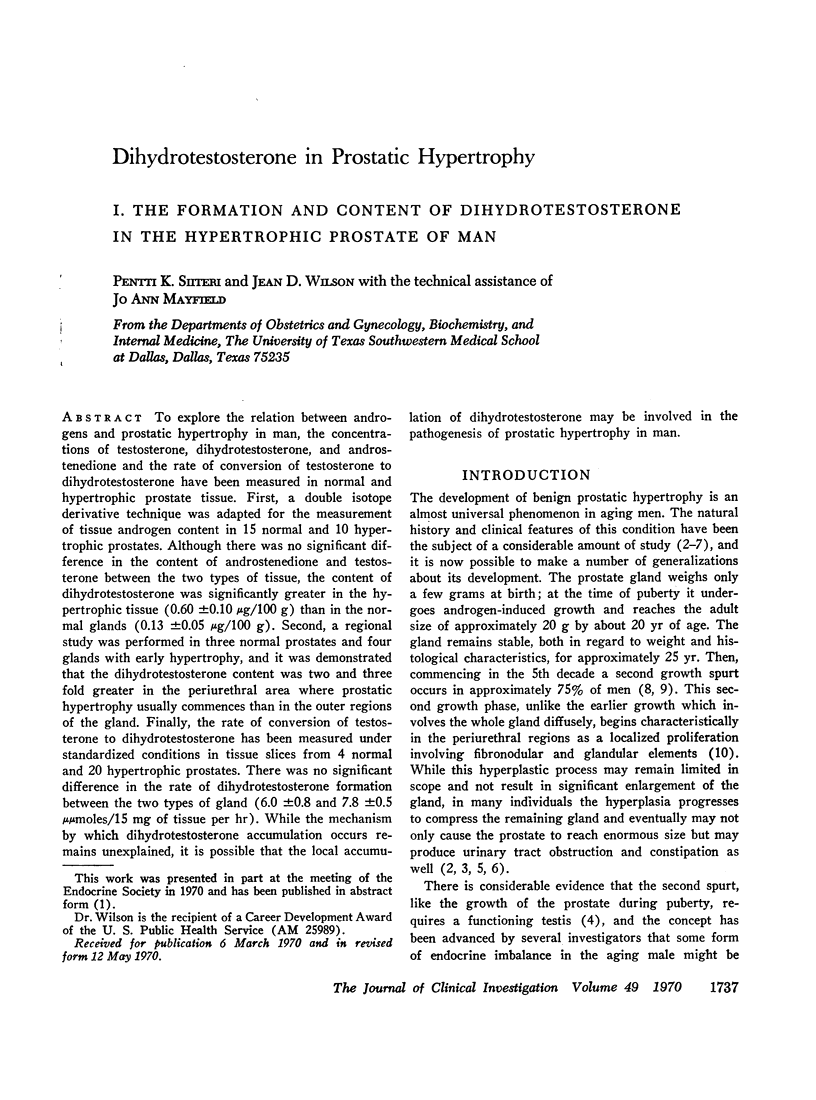
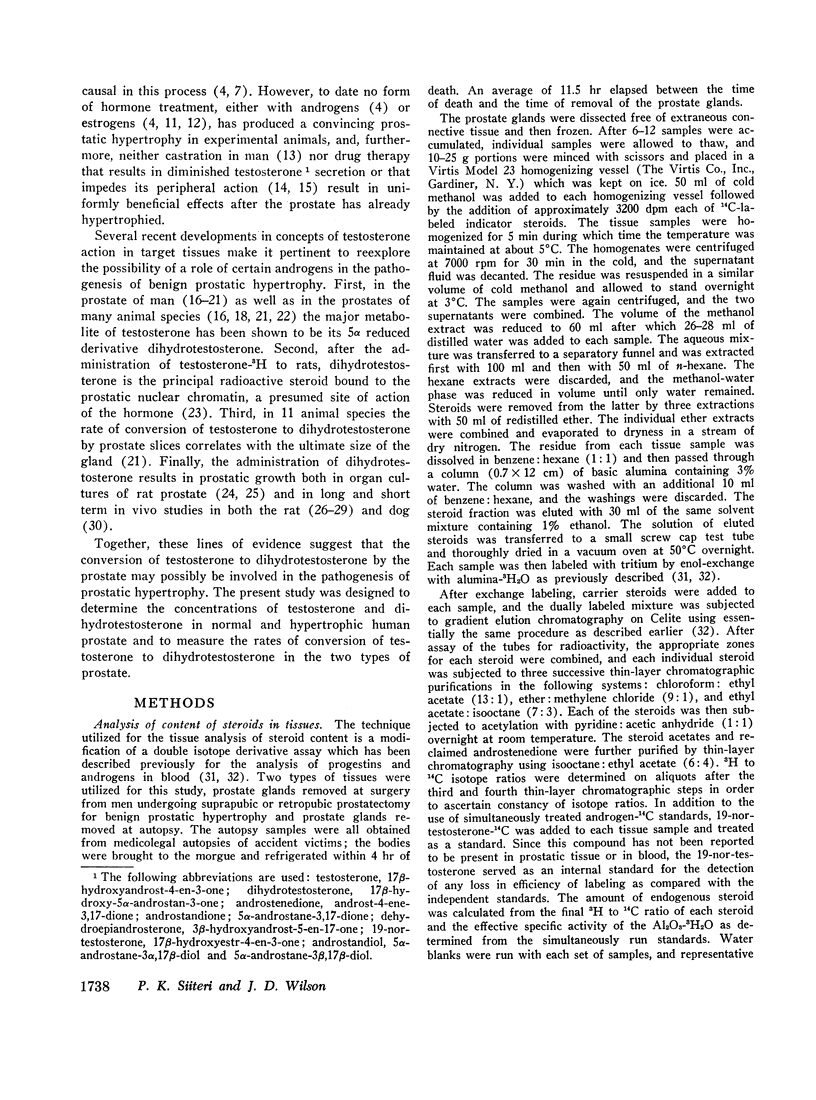
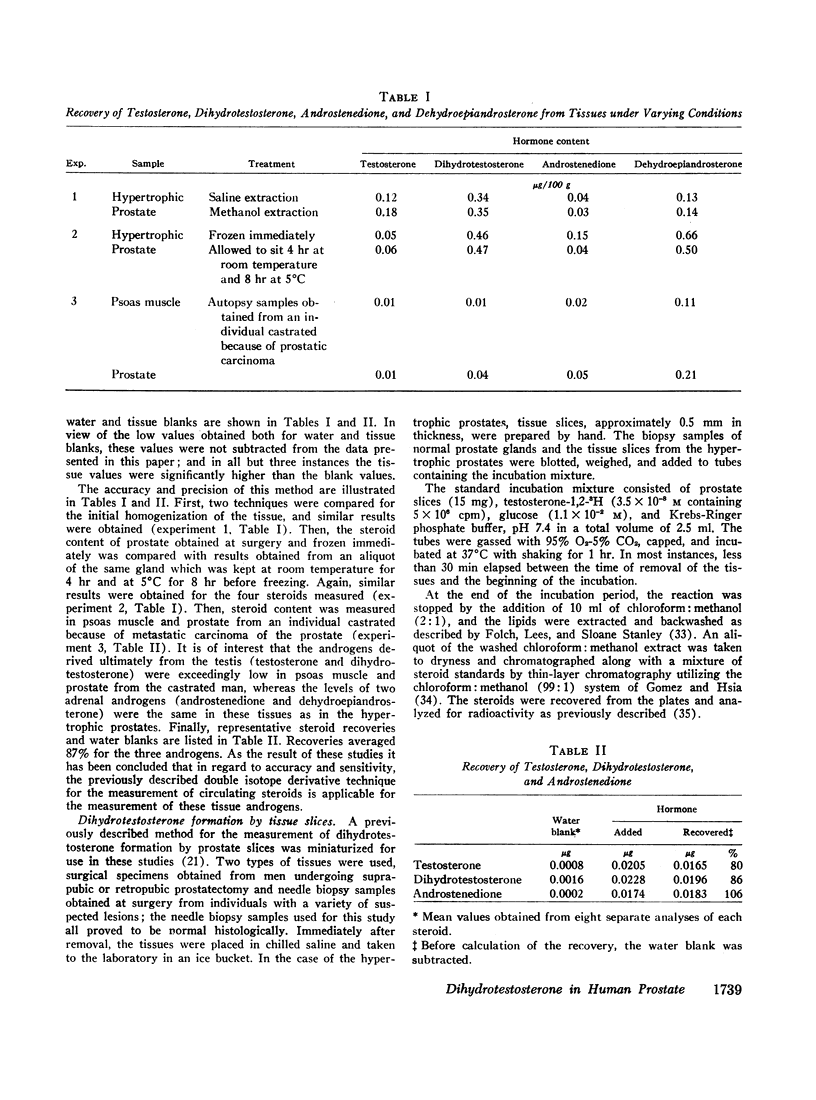
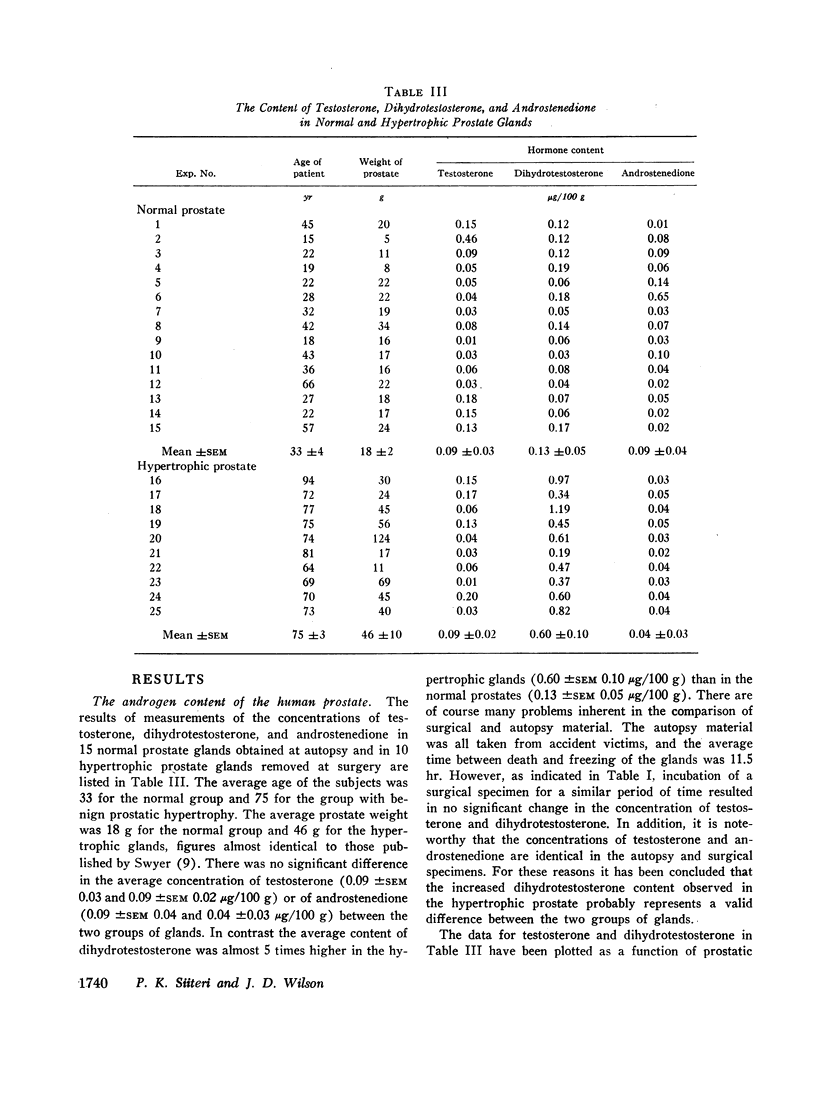


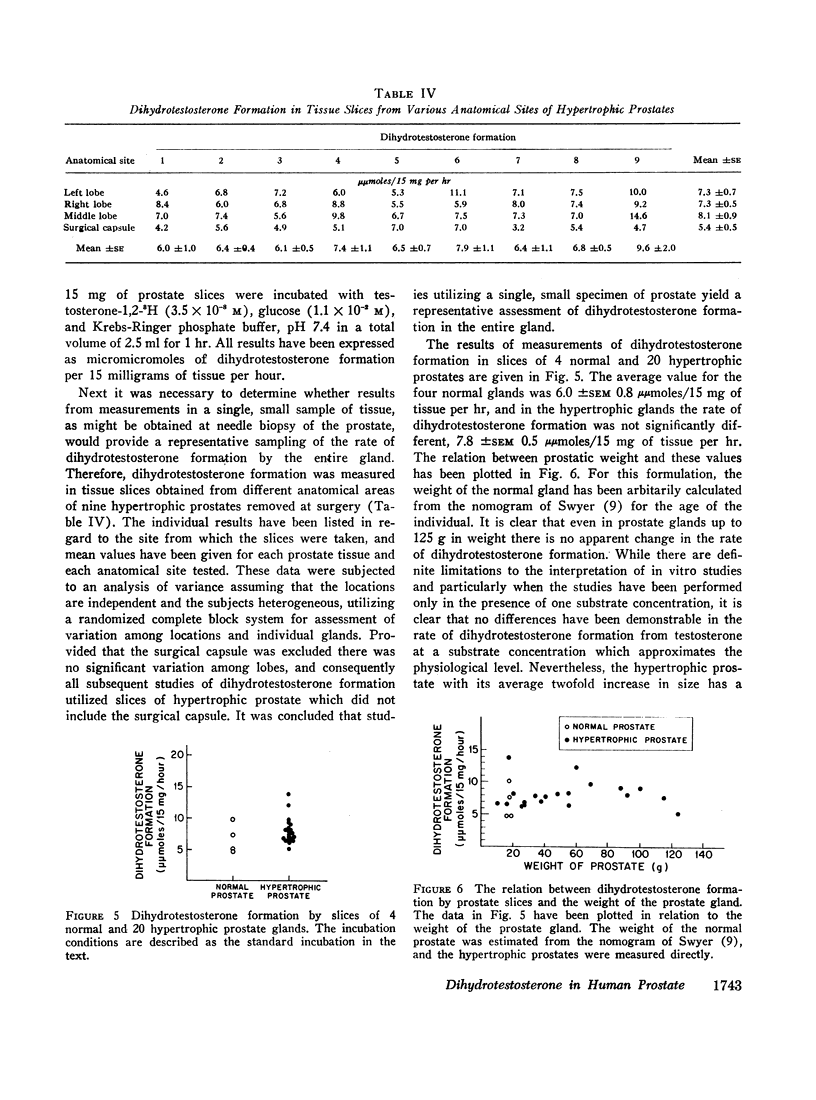
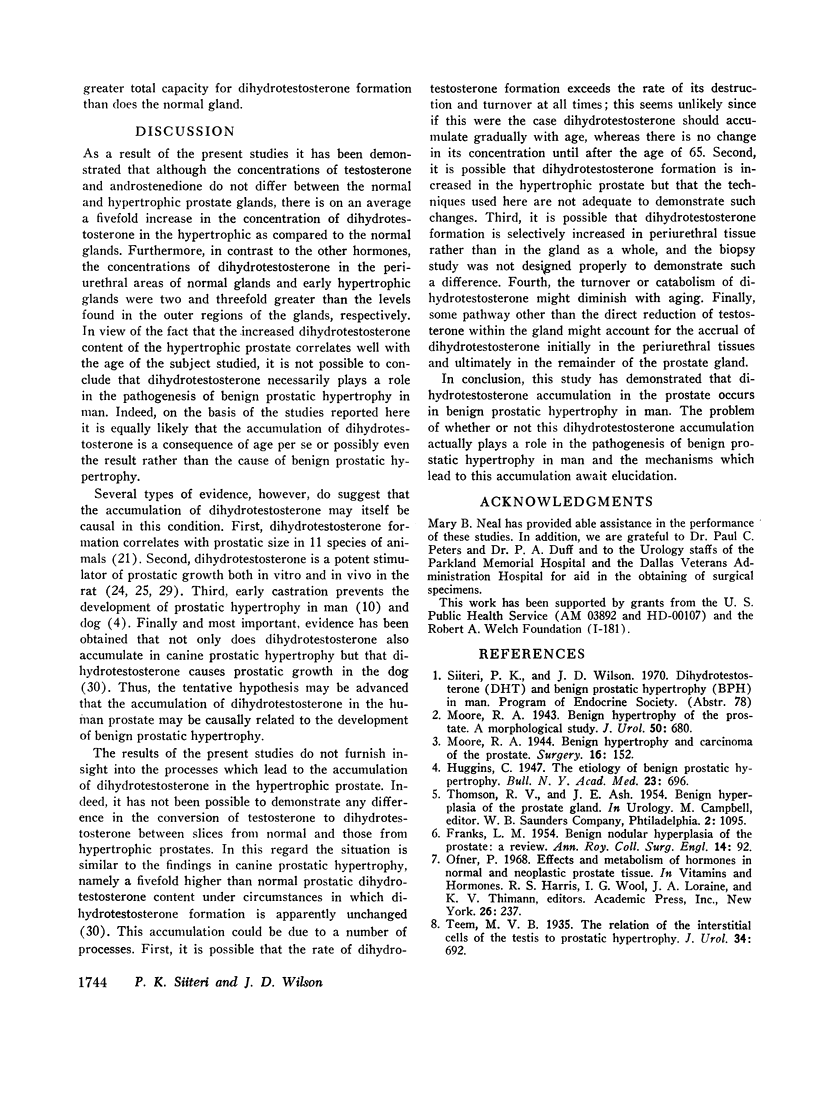

Images in this article
Selected References
These references are in PubMed. This may not be the complete list of references from this article.
- BERG O. A. Effect of stilboestrol on the prostate gland in normal puppies and adult dogs. Acta Endocrinol (Copenh) 1958 Feb;27(2):155–169. doi: 10.1530/acta.0.0270155. [DOI] [PubMed] [Google Scholar]
- Baulieu E. E., Lasnitzki I., Robel P. Testosterone, prostate gland and hormone action. Biochem Biophys Res Commun. 1968 Aug 13;32(3):575–577. doi: 10.1016/0006-291x(68)90702-x. [DOI] [PubMed] [Google Scholar]
- Baulieu E. E., Lasnizki I., Robel P. Metabolism of testosterone and action of metabolites on prostate glands grown in organ culture. Nature. 1968 Sep 14;219(5159):1155–1156. doi: 10.1038/2191155a0. [DOI] [PubMed] [Google Scholar]
- Bruchovsky N., Wilson J. D. The conversion of testosterone to 5-alpha-androstan-17-beta-ol-3-one by rat prostate in vivo and in vitro. J Biol Chem. 1968 Apr 25;243(8):2012–2021. [PubMed] [Google Scholar]
- Bruchovsky N., Wilson J. D. The intranuclear binding of testosterone and 5-alpha-androstan-17-beta-ol-3-one by rat prostate. J Biol Chem. 1968 Nov 25;243(22):5953–5960. [PubMed] [Google Scholar]
- Chamberlain J., Jagarinec N., Ofner P. Catabolism of [4-14C]testosterone by subcellular fractions of human prostate. Biochem J. 1966 Jun;99(3):610–616. doi: 10.1042/bj0990610. [DOI] [PMC free article] [PubMed] [Google Scholar]
- FARNSWORTH W. E., BROWN J. R. Metabolism of testosterone by the human prostate. JAMA. 1963 Feb 9;183:436–439. doi: 10.1001/jama.1963.63700060003011a. [DOI] [PubMed] [Google Scholar]
- FARNSWORTH W. E., BROWN J. R. TESTOSTERONE METABOLISM IN THE PROSTATE. Natl Cancer Inst Monogr. 1963 Oct;12:323–329. [PubMed] [Google Scholar]
- FOLCH J., LEES M., SLOANE STANLEY G. H. A simple method for the isolation and purification of total lipides from animal tissues. J Biol Chem. 1957 May;226(1):497–509. [PubMed] [Google Scholar]
- FRANKS L. M. Benign nodular hyperplasia of the prostate; a review. Ann R Coll Surg Engl. 1953 Feb;14(2):92–106. [PMC free article] [PubMed] [Google Scholar]
- GELLER J., BORA R., ROBERTS T., NEWMAN H., LIN A., SILVA R. TREATMENT OF BENIGN PROSTATIC HYPERTROPHY WITH HYDROXYPROGESTERONE CAPROATE: EFFECT ON CLINICAL SYMPTOMS, MORPHOLOGY, AND ENDOCRINE FUNCTION. JAMA. 1965 Jul 12;193:121–128. doi: 10.1001/jama.1965.03090020035009. [DOI] [PubMed] [Google Scholar]
- Gloyna R. E., Siiteri P. K., Wilson J. D. Dihydrotestosterone in prostatic hypertrophy. II. The formation and content of dihydrotestosterone in the hypertrophic canine prostate and the effect of dihydrotestosterone on prostate growth in the dog. J Clin Invest. 1970 Sep;49(9):1746–1753. doi: 10.1172/JCI106392. [DOI] [PMC free article] [PubMed] [Google Scholar]
- Gloyna R. E., Wilson J. D. A comparative study of the conversion of testosterone to 17-beta-hydroxy-5-alpha-androstan-3-one (Dihydrotestosterone) by prostate and epididymis. J Clin Endocrinol Metab. 1969 Jul;29(7):970–977. doi: 10.1210/jcem-29-7-970. [DOI] [PubMed] [Google Scholar]
- Gomez E. C., Hsia S. L. In vitro metabolism of testosterone-4-14C and delta-4-androstene-3,17-dione-4-14C in human skin. Biochemistry. 1968 Jan;7(1):24–32. doi: 10.1021/bi00841a004. [DOI] [PubMed] [Google Scholar]
- Rivarola M. A., Migeon C. J. Determination of testosterone and androst-4-ene-3, 17-dione concentration in human plasma. Steroids. 1966 Feb;7(2):103–117. doi: 10.1016/0039-128x(66)90019-5. [DOI] [PubMed] [Google Scholar]
- SAUNDERS F. J. SOME ASPECTS OF RELATION OF STRUCTURE OF STEROIDS TO THEIR PROSTATE--STIMULATING EFFECTS. Natl Cancer Inst Monogr. 1963 Oct;12:139–159. [PubMed] [Google Scholar]
- Scott W. W., Wade J. C. Medical treatment of benign nodular prostatic hyperplasia with cyproterone acetate. J Urol. 1969 Jan;101(1):81–85. doi: 10.1016/s0022-5347(17)62279-1. [DOI] [PubMed] [Google Scholar]
- Shimazaki J., Kurihara H., Ito Y., Shida K. Metabolism of testosterone in prostate. 2. Separation of prostatic 17-beta-ol-dehydrogenase and 5-alpha-reductase. Gunma J Med Sci. 1965 Dec;14(4):326–333. [PubMed] [Google Scholar]
- Shimazaki J., Kurihara H., Ito Y., Shida K. Testosterone metabolism in prostate; formation of androstan-17-beta-ol-3-one and androst-4-ene-3, 17-dione, and inhibitory effect of natural and synthetic estrogens. Gunma J Med Sci. 1965 Dec;14(4):313–325. [PubMed] [Google Scholar]
- Siiteri P. K., Tippit P., Yates C., Jr, Porter J. C. A double isotope procedure for the determination of progestins in rat ovarian vein blood. Endocrinology. 1968 Apr;82(4):837–843. doi: 10.1210/endo-82-4-837. [DOI] [PubMed] [Google Scholar]
- Swyer G. I. Post-natal growth changes in the human prostate. J Anat. 1944 Jul;78(Pt 4):130–145. [PMC free article] [PubMed] [Google Scholar]
- Wilson J. D., Walker J. D. The conversion of testosterone to 5 alpha-androstan-17 beta-ol-3-one (dihydrotestosterone) by skin slices of man. J Clin Invest. 1969 Feb;48(2):371–379. doi: 10.1172/JCI105994. [DOI] [PMC free article] [PubMed] [Google Scholar]



